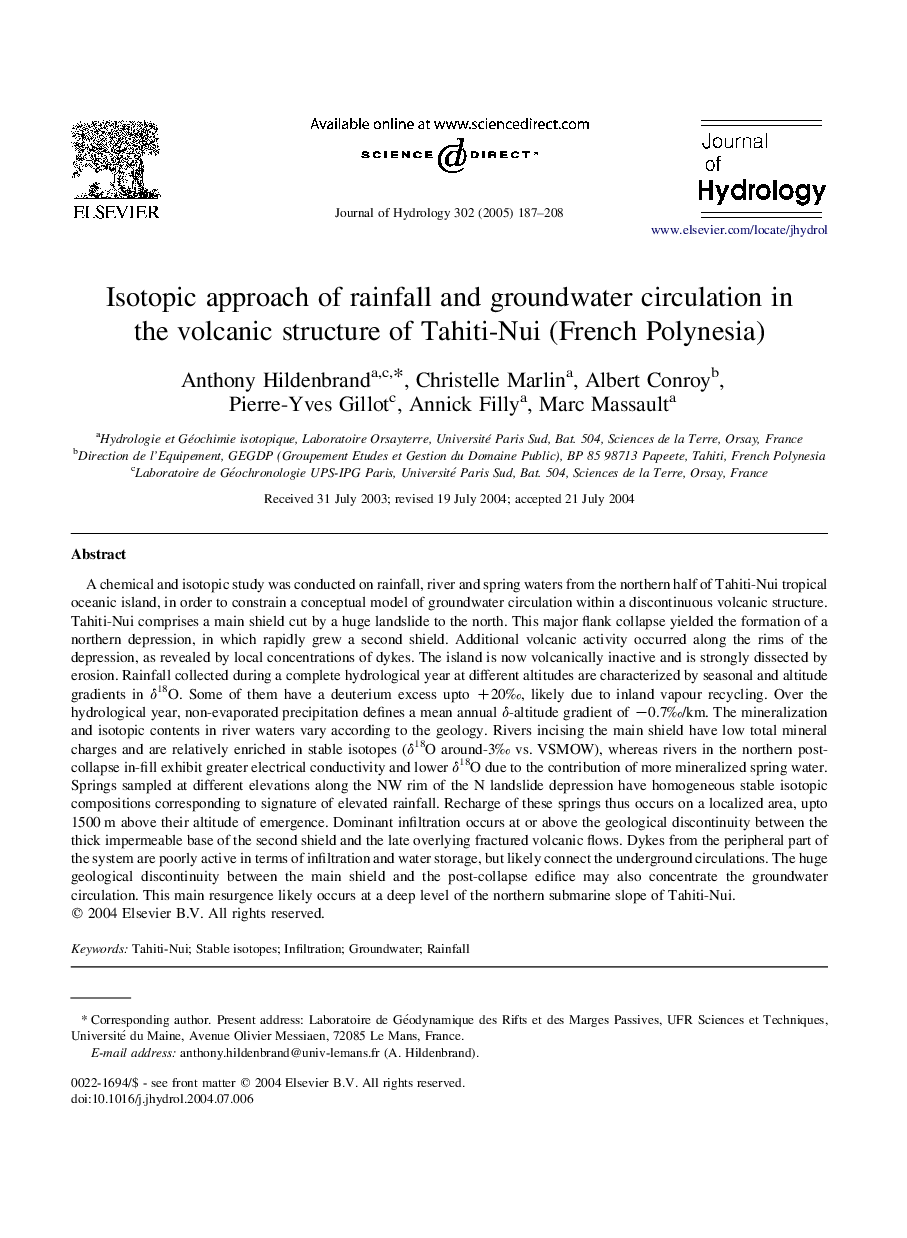| کد مقاله | کد نشریه | سال انتشار | مقاله انگلیسی | نسخه تمام متن |
|---|---|---|---|---|
| 9491436 | 1630189 | 2005 | 22 صفحه PDF | دانلود رایگان |
عنوان انگلیسی مقاله ISI
Isotopic approach of rainfall and groundwater circulation in the volcanic structure of Tahiti-Nui (French Polynesia)
دانلود مقاله + سفارش ترجمه
دانلود مقاله ISI انگلیسی
رایگان برای ایرانیان
کلمات کلیدی
موضوعات مرتبط
مهندسی و علوم پایه
علوم زمین و سیارات
فرآیندهای سطح زمین
پیش نمایش صفحه اول مقاله

چکیده انگلیسی
A chemical and isotopic study was conducted on rainfall, river and spring waters from the northern half of Tahiti-Nui tropical oceanic island, in order to constrain a conceptual model of groundwater circulation within a discontinuous volcanic structure. Tahiti-Nui comprises a main shield cut by a huge landslide to the north. This major flank collapse yielded the formation of a northern depression, in which rapidly grew a second shield. Additional volcanic activity occurred along the rims of the depression, as revealed by local concentrations of dykes. The island is now volcanically inactive and is strongly dissected by erosion. Rainfall collected during a complete hydrological year at different altitudes are characterized by seasonal and altitude gradients in δ18O. Some of them have a deuterium excess upto +20â°, likely due to inland vapour recycling. Over the hydrological year, non-evaporated precipitation defines a mean annual δ-altitude gradient of â0.7â°/km. The mineralization and isotopic contents in river waters vary according to the geology. Rivers incising the main shield have low total mineral charges and are relatively enriched in stable isotopes (δ18O around-3â° vs. VSMOW), whereas rivers in the northern post-collapse in-fill exhibit greater electrical conductivity and lower δ18O due to the contribution of more mineralized spring water. Springs sampled at different elevations along the NW rim of the N landslide depression have homogeneous stable isotopic compositions corresponding to signature of elevated rainfall. Recharge of these springs thus occurs on a localized area, upto 1500 m above their altitude of emergence. Dominant infiltration occurs at or above the geological discontinuity between the thick impermeable base of the second shield and the late overlying fractured volcanic flows. Dykes from the peripheral part of the system are poorly active in terms of infiltration and water storage, but likely connect the underground circulations. The huge geological discontinuity between the main shield and the post-collapse edifice may also concentrate the groundwater circulation. This main resurgence likely occurs at a deep level of the northern submarine slope of Tahiti-Nui.
ناشر
Database: Elsevier - ScienceDirect (ساینس دایرکت)
Journal: Journal of Hydrology - Volume 302, Issues 1â4, 1 February 2005, Pages 187-208
Journal: Journal of Hydrology - Volume 302, Issues 1â4, 1 February 2005, Pages 187-208
نویسندگان
Anthony Hildenbrand, Christelle Marlin, Albert Conroy, Pierre-Yves Gillot, Annick Filly, Marc Massault,